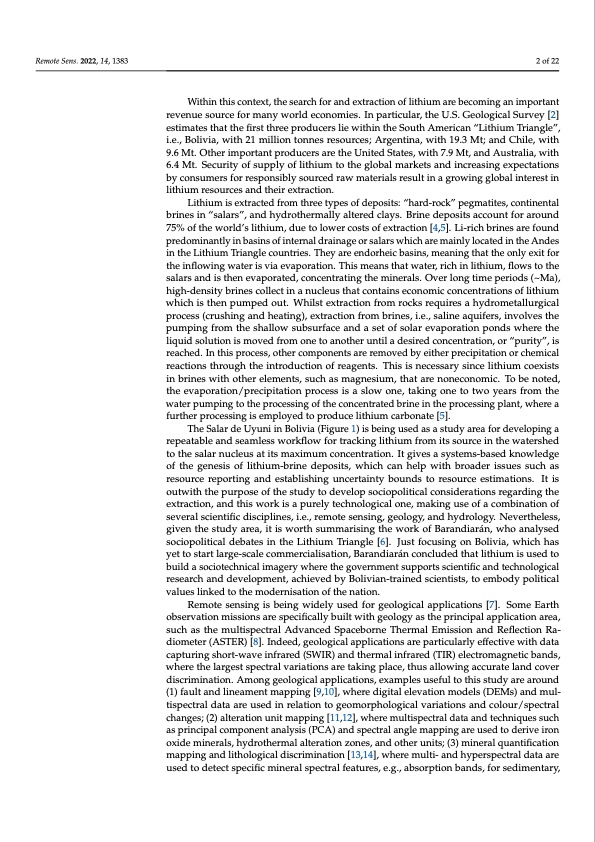
PDF Publication Title:
Text from PDF Page: 002
Remote Sens. 2022, 14, 1383 2 of 22 Within this context, the search for and extraction of lithium are becoming an important revenue source for many world economies. In particular, the U.S. Geological Survey [2] estimates that the first three producers lie within the South American “Lithium Triangle”, i.e., Bolivia, with 21 million tonnes resources; Argentina, with 19.3 Mt; and Chile, with 9.6 Mt. Other important producers are the United States, with 7.9 Mt, and Australia, with 6.4 Mt. Security of supply of lithium to the global markets and increasing expectations by consumers for responsibly sourced raw materials result in a growing global interest in lithium resources and their extraction. Lithium is extracted from three types of deposits: “hard-rock” pegmatites, continental brines in “salars”, and hydrothermally altered clays. Brine deposits account for around 75% of the world’s lithium, due to lower costs of extraction [4,5]. Li-rich brines are found predominantly in basins of internal drainage or salars which are mainly located in the Andes in the Lithium Triangle countries. They are endorheic basins, meaning that the only exit for the inflowing water is via evaporation. This means that water, rich in lithium, flows to the salars and is then evaporated, concentrating the minerals. Over long time periods (~Ma), high-density brines collect in a nucleus that contains economic concentrations of lithium which is then pumped out. Whilst extraction from rocks requires a hydrometallurgical process (crushing and heating), extraction from brines, i.e., saline aquifers, involves the pumping from the shallow subsurface and a set of solar evaporation ponds where the liquid solution is moved from one to another until a desired concentration, or “purity”, is reached. In this process, other components are removed by either precipitation or chemical reactions through the introduction of reagents. This is necessary since lithium coexists in brines with other elements, such as magnesium, that are noneconomic. To be noted, the evaporation/precipitation process is a slow one, taking one to two years from the water pumping to the processing of the concentrated brine in the processing plant, where a further processing is employed to produce lithium carbonate [5]. The Salar de Uyuni in Bolivia (Figure 1) is being used as a study area for developing a repeatable and seamless workflow for tracking lithium from its source in the watershed to the salar nucleus at its maximum concentration. It gives a systems-based knowledge of the genesis of lithium-brine deposits, which can help with broader issues such as resource reporting and establishing uncertainty bounds to resource estimations. It is outwith the purpose of the study to develop sociopolitical considerations regarding the extraction, and this work is a purely technological one, making use of a combination of several scientific disciplines, i.e., remote sensing, geology, and hydrology. Nevertheless, given the study area, it is worth summarising the work of Barandiarán, who analysed sociopolitical debates in the Lithium Triangle [6]. Just focusing on Bolivia, which has yet to start large-scale commercialisation, Barandiarán concluded that lithium is used to build a sociotechnical imagery where the government supports scientific and technological research and development, achieved by Bolivian-trained scientists, to embody political values linked to the modernisation of the nation. Remote sensing is being widely used for geological applications [7]. Some Earth observation missions are specifically built with geology as the principal application area, such as the multispectral Advanced Spaceborne Thermal Emission and Reflection Ra- diometer (ASTER) [8]. Indeed, geological applications are particularly effective with data capturing short-wave infrared (SWIR) and thermal infrared (TIR) electromagnetic bands, where the largest spectral variations are taking place, thus allowing accurate land cover discrimination. Among geological applications, examples useful to this study are around (1) fault and lineament mapping [9,10], where digital elevation models (DEMs) and mul- tispectral data are used in relation to geomorphological variations and colour/spectral changes; (2) alteration unit mapping [11,12], where multispectral data and techniques such as principal component analysis (PCA) and spectral angle mapping are used to derive iron oxide minerals, hydrothermal alteration zones, and other units; (3) mineral quantification mapping and lithological discrimination [13,14], where multi- and hyperspectral data are used to detect specific mineral spectral features, e.g., absorption bands, for sedimentary,PDF Image | Lithium Brine Deposit Formation

PDF Search Title:
Lithium Brine Deposit FormationOriginal File Name Searched:
remotesensing-14-01383-v2.pdfDIY PDF Search: Google It | Yahoo | Bing
Product and Development Focus for Infinity Turbine
ORC Waste Heat Turbine and ORC System Build Plans: All turbine plans are $10,000 each. This allows you to build a system and then consider licensing for production after you have completed and tested a unit.Redox Flow Battery Technology: With the advent of the new USA tax credits for producing and selling batteries ($35/kW) we are focussing on a simple flow battery using shipping containers as the modular electrolyte storage units with tax credits up to $140,000 per system. Our main focus is on the salt battery. This battery can be used for both thermal and electrical storage applications. We call it the Cogeneration Battery or Cogen Battery. One project is converting salt (brine) based water conditioners to simultaneously produce power. In addition, there are many opportunities to extract Lithium from brine (salt lakes, groundwater, and producer water).Salt water or brine are huge sources for lithium. Most of the worlds lithium is acquired from a brine source. It's even in seawater in a low concentration. Brine is also a byproduct of huge powerplants, which can now use that as an electrolyte and a huge flow battery (which allows storage at the source).We welcome any business and equipment inquiries, as well as licensing our turbines for manufacturing.| CONTACT TEL: 608-238-6001 Email: greg@infinityturbine.com | RSS | AMP |